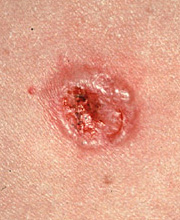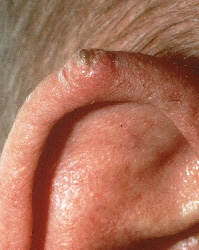Trilliumcreekohio.com




News and Information from
DERMATOLOGY & SURGERY CENTER
July / August 2015
Trillium Creek offers state-of-
the-art skin care, skin cancer
treatment, holistic medicine,
Helen M. Torok, M.D.
Medical Director
cosmetic treatments
Lice, Scabies, Impetigo,
Ringworm, Cold Sores
With back to school around the corner,
most parents are concerned with what their
children need to take to school to begin a
new year. Equal y important, though, is
what your child can bring home, in the
form of skin diseases.
Infestations (lice and scabies) and
Pictured left to right: Top row, Patrick Kil ian, MD; Suzanne Dade, CNP; Gary Rosenmeier, MD
infections (impetigo, ringworm
Bottom row, Judy Yetzer, CNP; Leonard Torok, MD; Helen Torok, MD; Francine Johns, PA-C
and cold sores) are a parent's
worst back-to-school nightmares.
Few places in the country offer the quality of care,
Add to that outbreaks of acne
innovation and state-of-the-art procedures that are
from stress, and children can
available at Trillium Creek. Trillium Creek offers
come home with more than
world-class dermatology, skin care, skin cancer
2 Dr. Patrick Killian:
treatments, holistic medicine, cosmetic treatments and
Know various types of
medical-grade skin care products.
continued on page 3
Medical directors and owners, Drs. Helen and Leonard
Torok, wanted to bring all possible resources available
3 Dr. Helen Torok: Kids
in dermatology on one campus for the benefit of
bring home more than
homework from school
The medical directors have assembled a staff of the
4 Meet the Trillium Creek
best and brightest in health care. Continuing medical
doctors and providers
education to stay abreast of the latest procedures and
modalities is an important part of the professional staff's
4 Cosmetic events and
commitment to providing Trillium Creek's patients and
clients the best care available.
continued on page 4




Mohs Skin Cancer Center
Patrick Killian, M.D.
Sun and Skin Cancer
What You Need To Know
by Patrick Killian, M.D.
There is a pervasive belief in our culture that a tan connotes health,
Warning Signs of the Three
affluence and beauty. Nothing could be further from the truth.
Most Common Skin Cancers
Hopeful y, someday soon, our culture will begin to look less favorably
at tanning, both outdoors and at tanning salons, as our knowledge of
the link between skin cancer and the harmful UV exposure associated
If you notice any of the following, see your dermatologist:
with tanning grows.
BCC (basal cell carcinoma)
l An open sore that bleeds, oozes, or crusts and
"I need a tan so I won't burn."
does not heal after two weeks.
Studies have shown that, at best, a tan gives a sun protectant factor
l Red/pink patch of skin that is scaly or flaky,
(SPF) of 2 to 3. More importantly, prolonged UV exposure leads to
may itch or hurt, and that persists for more than
DNA damage, suppression of certain aspects of the immune system
and photoaging, even in the absence of sunburn.
l A pink or pearly translucent bump or nodule that
may develop tiny blood vessels on its surface.
"I need to be in the sun to get my Vitamin D."
Humans obtain Vitamin D from UV exposure, diet and supplements.
Foods such as salmon, cod liver oil, fortified orange juice and dairy
SCC (squamous cell carcinoma)
products are rich in Vitamin D. Five to 10 minutes of noontime
l A persistent, scaly, red patch that sometimes
summer sun produces the maximum Vitamin D production possible
crusts or bleeds.
in the skin of a Caucasian. Further UV exposure causes increased
l A wart-like growth that enlarges within weeks
DNA damage, but will not produce more Vitamin D.
with a central indentation. l A raised, rough patch of skin that bleeds from
minor scratching or rubbing.
l Avoid the sun between 10:00 a.m. and 4:00 p.m. l Regular use of broad-spectrum sunscreen (SPF 30 or higher.
Look for products containing titanium dioxide, zinc oxide,
Melanoma – the ABCDEs
avobenzone, Mexoryl SX or helioplex.)
l Asymmetry. If you draw a line through a
l Wear sun-protective clothing and hats and UV-protective sunglasses.
mole, both halves should match.
l Examine your skin regularly and seek professional advice from
l Border. The borders of a melanoma may
your dermatologist about any suspicious areas. Get an annual skin
become uneven, scalloped or notched.
cancer screening from your dermatologist. Most skin cancers are
easily treated when caught early.
l Color. Melanoma will often be much darker
than other moles or have a variety of colors
Facts About the Sun
both darker and light mixed together. Rarely
l 90% of non-melanoma skin cancers are associated with sun
melanomas can be pink or red.
l Diameter. Usual y melanomas are larger
l 40% to 50% of Caucasian Americans who live to the age of 65 wil
than a pencil eraser, or ¼ of an inch. They
have a non-melanoma skin cancer at least once.
may be smaller if detected early.
l Up to 90% of visible changes associated with aging are caused by
Evolving. Any change in a mole – in size,
shape, color or elevation – should prompt an
Chronic sun exposure causes a sallow complexion, pigment,
evaluation by a dermatologist. TC
redness, wrinkling and increased skin laxity. l Of the estimated 1.3 million cases of skin cancer in the U.S.,
80% are basal cell carcinoma, 15% are squamous cell carcinoma
*Photos courtesy of Interactive Dermatology Atlas
and 3% are melanomas.
2 l Trillium Creek l 5783 Wooster Pike l Medina, Ohio 44256 l 330.725.0569 l TrilliumCreekOhio.com
Dermatology & Surgery
continued from page 1
Home From School
The relatively "new kid on the block" to worry about is the
"superbug" MRSA. Methicillin-resistant Staphulococcus aureus
is considered one of the "superbugs" – a staph bacterium that's
resistant to broad-spectrum antibiotics usual y prescribed to treat
it. "Community" acquired MRSA can be particularly dangerous in
children, often entering the body through a cut or scrape. It can cause
Ringworm is actual y not a worm, but a fungus called a dermatophyte.
widespread infection. Children may be more susceptible to MRSA
It appears as a red raised scaly patch, often with sharply defined
because their immune systems are not ful y developed. Participating
edges that may blister and ooze. Often the blister is flesh-toned on
in contact sports, sharing towels, athletic equipment, razors, and being
the inside and red on the outside giving the condition its name.
in crowded or unsanitary conditions are contributing risk factors.
Topical creams can treat ringworm anywhere except on the scalp.
For ringworm on the scalp, an oral tablet, Lamisil, is prescribed.
Lice typical y affect the head and can jump from one child to another.
Otherwise it can invade the hair follicle.
Because children touch one another and share hats and combs, lice
Cold Sores, Stress
can very easily infect an entire school and family once a youngster
With the excitement and anticipation of a new school year, as well
as sports, homework and dating, comes a lot of stress. Sometimes
If you part the hair, you will see little white eggs at the base of the hair
this stress is manifested in cold sores (herpes simplex) and acne.
shaft and live insects above the ear and back of the head. Lice itch.
Stress can aggravate cold sores as well as contact sports, sunburns
Contrary to popular belief, lice don't come from being dirty.
and dry, chapped lips. Keeping the lips hydrated is the best way to
prevent cold sores. Students should not share lipsticks and drinks.
Lice are treated with Kwell shampoo and a vinegar rinse.
Touching the blisters or kissing when they are active should be
A 100 percent cure is to massage Cetaphil cleanser into the hair
avoided. An oral medication, Valtrex, is very helpful in preventing
and scalp for 15 minutes, blow dry for 15 minutes and rinse.
these outbreaks.
This treatment suffocates the lice. Scabies
It's a good idea not to share anything with other students – makeup,
combs, ChapStick, clothing, washcloths.
While lice are visible to the naked eye and are on top of the skin,
scabies mites burrow under the skin. They itch the worst at night
Acne is another manifestation of stress, affecting 70 percent
and like the webs of the hands and palms of younger children. A
of teens. Have your children see the physicians and physician
female can lay 100 eggs per night and they hatch within a week. Once
assistants at Trillium Creek early in the school year so they can
exposed, it can be as long as three weeks before symptoms appear.
provide treatments such as topical medications, cleansers, non-
Scabies infestations, like lice, can become epidemic if not treated early
comedogenic makeup, oral medications and sunblocks to clear the
and in all exposed children, family members and friends. Treatment
acne. Caffeine should be limited, as it can aggravate acne.
includes an oral medication, Stromectol.
In females, acne can be hormonal y driven. So birth control pil s
are sometimes used to regulate hormones, as well as antibiotics,
Wrestlers and close contact sports participants are especial y at risk for
topicals such as Retin-A and benzoyl peroxide, and in severe cases,
impetigo and any of the contagious diseases. The staphylococcal and
Accutane. Girls should avoid heavy makeup and use a powder-
streptococcal bacteria enters a cut or a scratch and impetigo spreads
based makeup, like the H&H Skin Science line at The Boutique
like wildfire. Be on the lookout for sores around the lips or nose,
at Trillium Creek & Salon. It doesn't block pores and provides
which turn into a honey-colored crust within days. This is a highly
excellent coverage.
contagious disease and must be treated with an oral antibiotic when
In boys, sports can aggravate acne. In sports that use helmets, the
extensive. Because it is a streptococcal infection, kidney problems can
area where the helmet touches the skin is a reservoir for sweat and
occur just as in strep throat.
bacteria providing an excellent breeding ground for acne. The same
types of treatments (except birth control) are used to treat acne in
males and females. TC
3 l Trillium Creek l 5783 Wooster Pike l Medina, Ohio 44256 l 330.725.0569 l TrilliumCreekOhio.com
Meet the Professional Staff
continued from page 1
Helen M. Torok, MD, is the Medical Director
for the Dermatology and Surgery Center at Trillium
Creek. Dr. Torok is considered an expert both in
medical and cosmetic dermatology, earning an
excellent reputation in her specialty: diagnosing
and treating disorders of the skin, hair and nails.
She is also known for her expertise in lip and facial
Leonard J. Torok, MD, board certified orthopedic
surgeon and holistic medicine practitioner, directs
Mark Your Calendar .
the Ohio Holistic Medicine Center and the cosmetic
laser center at Trillium Creek. Dr. Torok, a published
You don't want to miss out on
book author and lecturer, has used combinations of
these valuable offers!
surgery and holistic medicine for 32 years in Medina.
Patrick Killian, MD, is a board certified
dermatologist and Mohs cancer surgeon specializing
in the removal and repair of skin cancers of the head,
l Cosmetic Evenings 10% off
face and neck. He has performed Mohs surgery for
- Medina: July 2, 9, 16, 23
more than 12 years and has removed more than
15,000 cancers during his time at Trillium.
- Wooster: July 8, 15, 22
l 20% off Botox/Dysport: July 18, Wooster
Gary J. Rosenmeier, MD, is a board certified
l 20% off Sculptra - for filling hollows
dermatologist skilled in medical and surgical
l 20% off ClearToe - for fungus of nails
dermatology with more than 25 years experience
l 15% off all Body Shaping Procedures
in treating diseases of the skin, hair and nails.
l Botox Juvederm Combo $899 ($1,150 value)
Dr. Rosenmeier has a distinguished Army career, and
served as Chief of Dermatology in the United Stated
Army Medical Corps.
Francine Johns, PA-C, has been with Trillium
l Juvederm $800 ($1,200 value)
Creek since 2000 and has been a certified physician
l 20% off VeinWave
assistant for more than 20 years. As a physician
l 20% off Botox/Dysport: August 22, Medina
assistant, she performs a wide range of procedures
l 20% off Sculptra: August 29, Medina
under physician supervision. She specializes in full
body skin cancer screenings.
Judy Yetzer, CNP, has been a nurse for more
than 25 years in various clinical settings including
Before & After
pediatric, intensive care, coronary intensive care,
emergency care, outpatient clinics and radiation
oncology. She now focuses on the goal of providing
preventive skin care as a nurse practitioner.
Suzanne Dade, CNP, is a nurse practitioner from
the US Army Nurse Corps with 22 years of service,
and has practiced in a variety of clinical settings. Her
specialty is psoriasis and she has extensive experience
and training in the use of multiple treatment
modalities and therapies for its treatment.
The entire professional and medical staff at Trillium Creek is dedicated to
providing you with the best quality skin care that medicine and technology
To receive an email with more information about these and
future promotions, please send an email to [email protected].
4 l Trillium Creek l 5783 Wooster Pike l Medina, Ohio 44256 l 330.725.0569 l TrilliumCreekOhio.com
Source: https://www.trilliumcreekohio.com/uploads/4/5/6/1/45615923/hmt-julyaug2015.pdf
N° 10 Abril 2013 Publicación de contenido científico editada por GT Laboratorio S.R.L. Necochea 3274 Rosario Método enzimático UV para la determinación cuantitativa de lactato en suero, plasma o líquido LACTATO Liquid Plus cefalorraquídeo. El nuevo método enzimático UV GT Lab para la determinación de lactato permite la cuantificación rápida y precisa, empleando un reactivo de tra-bajo único de sencilla preparación. Dicha preparación se hace por disolución de un polvo en el buffer provis-to listo para usar. El reactivo de trabajo es estable 24 horas a temperatura ambiente o 15 días refrigerado. Se resume seguidamente el documento "Lactato: utilidad clínica y reco-mendaciones para su medición", de la Sociedad Española de Química Clí-nica preparado por P. Guevara Ramírez, R. Díaz García, A. Galán Ortega, E. Guillén Campuzano, S. Malumbres, J.L. Marín Soria, M. Muñoz Pérez, X. Navarro Segarra, P. Oliver Sáez, E. Oujo, N. del Río Barcenilla y A. Buño Soto en 2010.
Environ. Sci. Technol. 2003, 37, 2400-2409 Fate and Transport of 17â-Estradiol great number of people and wildlife can be impacted byexposure to reproductive hormones, especially since they in Soil-Water Systems can produce adverse effects at remarkably low concentrations(<1.0 ng L-1; 2-4). For example, 17â-estradiol has been foundto cause vitellogenin production in male fish at environmental









